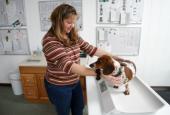Fido needs to lose the love handles? Send him to camp
Hutto woman starts residential diet, exercise program for obese dogs
AMERICAN-STATESMAN STAFF
Tuesday, January 02, 2007
HUTTO — Big Boy Roy was living up to his name. The piebald dachshund's belly swung dangerously close to the ground. His torso swelled from breakfast link to bratwurst. His stubby legs bowed under his growing weight. It was time for Roy to go to doggie fat camp.
Sherry Rogers opened her camp for portly pups late last year at the dachshund boarding and breeding business she runs out of her Hutto home.

Brian K. Diggs photos
AMERICAN-STATESMAN
Roy gets a weigh-in to see how his pound-shedding is coming along.
Rogers, 38, created the camp after seeing too many of her customers' puppies become "overly loved," as she puts it. For $600 a month, Rogers will put dogs like Roy on a customized exercise and diet plan and board them for a month. Within weeks, Rogers expects canine clients will see a newer, slimmer self, she says.
Roy is Rogers' first client, but with more people treating — and feeding — pets like family, it's a business Rogers expects will grow.
Veterinarian Ron Stried of Tanglewood Animal Hospital in South Austin estimates that about half of the dogs he sees are overweight or obese, significantly more than when he first started practicing more than 35 years ago.
Stried, treasurer of the Texas Veterinary Medical Association, chalks up the increase to high-calorie treats, owners getting their dogs spayed or neutered, and dogs being kept in apartments or on a leash getting less exercise and sometimes adopting their owners' sedentary habits.
"A lot of the time when we go into the (examination) room, the dogs and the people are carrying the same weight," he said.
Like overweight people, overweight dogs can experience a variety of health problems like heart and respiratory conditions, diabetes and high blood pressure, and strained joints that put them at risk for arthritis, Stried said.
Though the idea of an all-day doggie fat camp may be new, vets have been helping owners help their dogs lose weight for years by choosing a dog food designed for weight control, limiting how much the dog is fed and making sure it gets regular exercise, Stried said.
But doggie fat camp isn't necessarily a silly idea, he said.
"If people want their pet to lose weight and they can spend the money on it, it's great," he said.
Other Austin-area dog training and boarding facilities have residential training programs and doggie daycare exercise programs, but Rogers hasn't heard of any other similar canine fat camps.
Babs Chandrasoma, a 40-year-old medical marketer and part-time publicist from Wells Branch, bought Roy from Rogers as a puppy about three years ago. Chandrasoma and her family were looking for a "little family lap dog that would hang out with us," Chandrasoma explained.
Roy fit the bill. He was happy to doze under the covers of Chandrasoma's and her husband's bed during the day and cuddle on the couch at night.
"He could care less if he slept all day," Chandrasoma said.
Rogers' young daughters had named Roy "Big Boy Roy" because he was the largest puppy in his litter. But the Chandrasomas soon gave him a nickname Hoover — for his dedication to vacuuming up every atom of dropped food.
When Roy, who stands about 10 inches high, grew to nearly 20 pounds, they knew it was time to act.
Because Roy was Rogers's first outside client, she put him through the camp free of charge. But Chandrasoma said she would have paid the full fee if necessary, figuring it could save her thousands in vet bills later on.
Rogers, who consulted Pflugerville Animal Hospital veterinarian Vijay Gudipallyon the design of her doggie fat camp, has prospective clients examined to ensure that they're healthy enough for intense exercise. Then she puts the dogs on a diet, including a high-fiber dog food and plenty of fresh vegetables, cottage cheese, brown rice and ground meat; gives them a daily vitamin; and gets them on an exercise program. The exercise can include swimming in Rogers' above-ground pool, taking long walks on winding Williamson County roads, frolicking with other boarders and Rogers' half-acre yard, or jogging on a treadmill. Roy has lost 2 1/2 pounds in five weeks, Rogers said.
"There's no fancy food or pills," Rogers said. "It's just exercise and monitoring food intake."
Stried, the south Austin vet, agreed that less food and more exercise will help most overweight dogs drop the weight.
"It's a lot harder," he said. "If you've got a (fat) cat."

